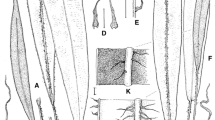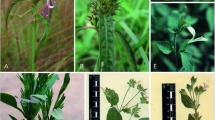Abstract
Discomycetes of the family Hyaloscyphaceae were collected from across Japan and identified. In this report, non-glassy-haired members of the tribe Hyaloscypheae, subfamily Hyaloscyphoideae are described and illustrated. The five species involved include one new species (Phialina lacrimiformis) and four species less well known or newly reported in Japan (Dematioscypha dematiicola, Hamatocanthoscypha laricionis var.Iaricionis, Micropodia chrysostigma, M. grisella). cultural studies were carried out, and teleomorph-anamorph relationships are discussed forD. dematiicola, H. laricionis val.laricionis and their anamorphs. A key to the genera of the tribe Hyaloscypheae in Japan is provided.
Similar content being viewed by others
Literature cited
Bøhler, H. C. 1974. Taxonomical studies on some Norwegian Helotiales (Ascomycetes) on fern remains. Norw. J. Bot.21: 79–100.
Dennis, R. W. G. 1949. A revision of the British Hyaloscyphaceae, with notes on related European species. Mycol. Pap.32: 1–97.
Dennis, R. W. G. 1956. A revision of the British Helotiaceae in the herbarium of the Royal Botanic Gardens, Kew, with notes on related European species. Mycol. Pap.62: 1–216.
Ellis, M. B. 1971. Dematiaceous Hyphomycetes, pp. 365–366. C. M. I., Kew, Surrey, U. K.
Haines, J. H. 1984. Studies in the Hyaloscyphaceae III: the long-spored, lignicolous species ofLachnum. Mycotaxon19: 1–39.
Hino, I. and Katumoto, K. 1961. Icones fungorum babusicolorum Japonicorum. The Fuji Bamboo Garden.
Hughes, S. J. 1953. Conidiophores, conidia, and classification. Can. J. Bot.31: 577–659.
Huhtinen, S. 1987. Taxonomic studies in the generaProtounguicularia, Arachnopeziza andDematioscypha. Mycotaxon30: 9–28.
Huhtinen, S. 1989. Monograph ofHyaloscypha and allied genera. Karstenia29: 45–252.
Huhtinen, S. 1994. Traditional discomycete taxonomy: should we also shift to a second gear? In: Ascomycete systematics: problems and perspectives in the nineties, (ed. by Hawksworth, D. L.), pp. 295–302. Plenum Press, New York.
Korf, R. P. 1958. Japanese discomycete notes I–VIII. Sci. Rept. Yokohama Nat. Univ. Sect. II.7: 7–35.
Korf, R. P. 1959. Japanese discomycete notes IX–XVI. Bull. Natn. Sci. Mus. Tokyo45: 389–400.
Korf, R. P. 1973. Discomycetes and Tuberales. In: The fungi, vol. IV A, (ed. by Ainsworth, D. L., Sparrow, F. K. and Sussman, A. S.), pp. 249–319. Academic Press, New York.
Korf, R. P. 1978. Revisionary studies in Arachnopezizoideae: a monograph of the Polydesmieae. Mycotaxon7: 457–492.
Korf, R. P. 1985. A compendium of currently valid names for species illustrated in volumes 2 and 3 of Boudier's lcones Myclogicae, pp. 209–252. Editions Piantanida, Lausanne, Switzerland.
Korf, R. P. 1990. Discomycetes systematics today: a look at some unanswered questions in a group of unitunicate ascomycetes. Mycosystema3: 19–27.
Kornerup, A. and Wanscher, J. H. 1978. Methuen handbook of colour, 3rd ed. Eyre Methuen, London.
Nannfeldt, J. A. 1932. Studien über die Morphologie und Systematik der nicht-lichenisierten inoperculaten Discomyceten. Nova Acta Reg. Soc. Sci. Upsal., Ser. IV,8: 1–368.
Oguchi, T. 1981. Studies on the species ofLachnellula in Hokkaido: Their morphology, physiology, and pathogenicity. Bull. Hokkaido For. Exp. Stn.19: 187–246.
Otani, Y. 1967. Notes on some cup fungi of the Hyaloscyphaceae collected in Hokkaido, Japan. Trans. Mycol. Soc. Japan8: 33–42.
Otani, Y. 1989. List of discomycete fungi recorded from Japan. Sci. Rept. Yokosuka City Mus.37: 61–81. (In Japanese.)
Otani, Y. and Tubaki, K. 1976. Notes on the cup fungi and imperfect fungi in Yakushima. Mem. Natn. Sci. Mus.9: 77–84. (In Japanese.)
Skerman, V. B. D. 1968. A new type of micromanipulator and microforge. J. Gen. Microbiol.54: 287–297.
Spooner, B. M. 1987. Helotiales in Australasia: Geoglossaceae, Orbiliaceae, Sclerotiniaceae, Hyaloscyphaceae. Bib. Mycol.116: 1–711.
Suto, Y. 1992. A new species ofCistella (Discomycetes) inhabiting bark ofChamaecyparis obtusa andCryptomeria japonica, and its cultural characters. Trans. Mycol. Soc. Japan33: 433–442.
Sutton, B. C. and Hennebert, G. L. 1994. Interconnections amongst anamorphs and their possible contribution to ascomycete systematics. In: Ascomycete systematics: problems and perspectives in the nineties, (ed. by Hawksworth, D. L.), pp. 77–100. Plenum Press, New York.
Svrček, M. 1976. New or less known Discomycetes. III. Česká Mykol.30: 8–16.
Svrček, M. 1977. New or less known Discomycetes. VI. Česká Mykol.31: 193–200.
Svrček, M. 1985. Notes on the genusHyaloscypha (Helotiales). Česká Mykol.39: 205–219.
Svrček, M. 1987. The European genera of the family Hyaloscyphaceae (Helotiales). Česká Mykol.41: 193–206.
Author information
Authors and Affiliations
About this article
Cite this article
Hosoya, T., Otani, Y. Hyaloscyphaceae in Japan (1): Non-glassy-haired members of the tribe hyaloscypheae. Mycoscience 38, 171–186 (1997). https://doi.org/10.1007/BF02460853
Accepted:
Issue Date:
DOI: https://doi.org/10.1007/BF02460853




